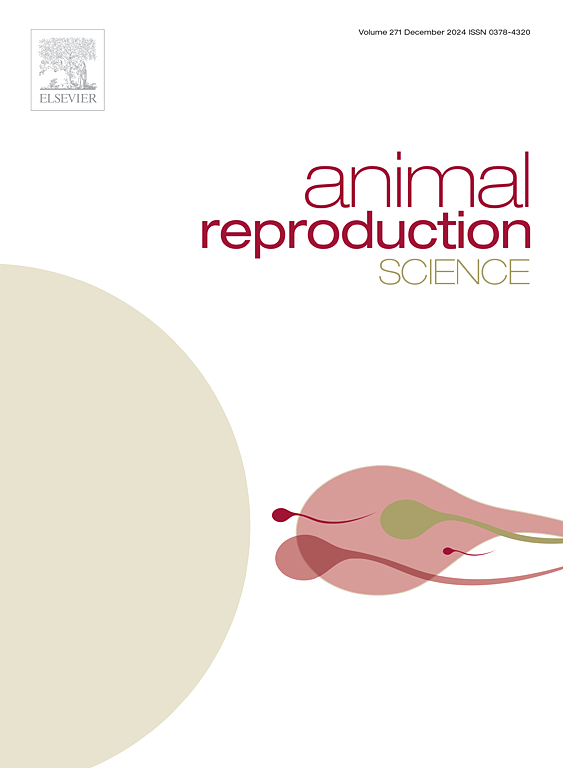The effect of freezing and thawing techniques on the in vitro quality of pellet-frozen ram semen
IF 2.2
2区 农林科学
Q1 AGRICULTURE, DAIRY & ANIMAL SCIENCE
引用次数: 0
Abstract
The post-thaw quality of pellet-frozen ram semen was evaluated based on (i) sperm concentration, (ii) thawing diluent, and (iii) the number of pellets thawed simultaneously. Ejaculates from three Merino rams were collected, with four replicates per ram (n = 12 ejaculates) for each experiment. In Experiment 1, ejaculates were frozen at 200, 400, 600 or 800 × 106 sperm/ mL. In Experiment 2, ejaculates were frozen at 600 × 106 sperm/ mL and thawed in a dry test tube (control) or with 1 + 3 tris-citrate-fructose, tris-citrate-fructose+egg yolk, PBS+dye, PBS alone or IVF media (Emcare). In Experiment 3, groups of 1, 2 or 3 pellets were thawed in tris-citrate-fructose or a dry test tube (control). Post-thaw samples were tested for motility, acrosome and membrane integrity (FITC-PNA/PI) at 0, 3, and 6 h (all Experiments) and morphology at 0 h (Experiment 1). At 3 and 6 h post-thaw, motility was reduced at 200 × 10⁶ sperm/mL compared to other concentrations (P < 0.05). Across all time points, samples frozen at 800 × 10⁶ sperm/mL (P < 0.05) showed lower viability, while freezing at 200 × 10⁶ sperm/mL increased morphological abnormalities (P < 0.05). Thawing pellets with tris-citrate-fructose media resulted in higher motility, acrosome and membrane integrity 0, 3 and 6 h post-thaw (P > 0.05). Thawing one-pellet in tris-citrate-fructose improved motility and viability post-thaw (P < 0.05) compared to multiple pellets, while the number of pellets thawed had no significant effect when dry-thawed (P > 0.05). The results suggest that the optimal post-thaw quality is achieved when semen is frozen between 400 and 600 × 106 sperm/mL and thawed in tris-citrate-fructose media, one pellet at a time.
冷冻和解冻技术对颗粒冷冻公羊精液体外质量的影响
根据(i)精子浓度、(ii)解冻稀释液和(iii)同时解冻的球粒数量来评估融球冷冻公羊精液的解冻后质量。采集3只美利奴公羊的射精,每只公羊4个重复(n = 12只射精)。在实验1中,射精液以200、400、600或800 × 106个精子/ mL冷冻。在实验2中,射精液以600 × 106个精子/ mL冷冻,并在干燥试管(对照)或1 + 3三柠檬酸盐-果糖、三柠檬酸盐-果糖+蛋黄、PBS+染料、PBS单独或IVF培养基(Emcare)中解冻。在实验3中,1、2或3组微球在三柠檬酸果糖或干试管(对照)中解冻。解冻后的样品在0、3和6 h(所有实验)和0 h(实验1)检测活力、顶体和膜完整性(FITC-PNA/PI)和形态学。在解冻后3和6 h, 200 × 10 26精子/mL的浓度与其他浓度相比,活力降低(P <; 0.05)。在所有时间点,800 × 10⁶精子/mL (P <; 0.05)冷冻的样本活力较低,而200 × 10⁶精子/mL冷冻的样本形态异常增加(P <; 0.05)。以三柠檬酸盐-果糖为培养基的解冻微球在解冻后0、3和6 h具有更高的运动性、顶体和膜完整性(P >; 0.05)。三柠檬酸-果糖单粒解冻比多粒解冻能提高解冻后的活力和活力(P <; 0.05),而干解冻时,融球数量对运动和活力没有显著影响(P >; 0.05)。结果表明,在400 ~ 600 × 106个精子/mL之间冷冻,在三柠檬酸盐-果糖培养基中解冻,每次一粒,解冻后的精液质量最佳。
本文章由计算机程序翻译,如有差异,请以英文原文为准。
求助全文
约1分钟内获得全文
求助全文
来源期刊

Animal Reproduction Science
农林科学-奶制品与动物科学
CiteScore
4.50
自引率
9.10%
发文量
136
审稿时长
54 days
期刊介绍:
Animal Reproduction Science publishes results from studies relating to reproduction and fertility in animals. This includes both fundamental research and applied studies, including management practices that increase our understanding of the biology and manipulation of reproduction. Manuscripts should go into depth in the mechanisms involved in the research reported, rather than a give a mere description of findings. The focus is on animals that are useful to humans including food- and fibre-producing; companion/recreational; captive; and endangered species including zoo animals, but excluding laboratory animals unless the results of the study provide new information that impacts the basic understanding of the biology or manipulation of reproduction.
The journal''s scope includes the study of reproductive physiology and endocrinology, reproductive cycles, natural and artificial control of reproduction, preservation and use of gametes and embryos, pregnancy and parturition, infertility and sterility, diagnostic and therapeutic techniques.
The Editorial Board of Animal Reproduction Science has decided not to publish papers in which there is an exclusive examination of the in vitro development of oocytes and embryos; however, there will be consideration of papers that include in vitro studies where the source of the oocytes and/or development of the embryos beyond the blastocyst stage is part of the experimental design.
 求助内容:
求助内容: 应助结果提醒方式:
应助结果提醒方式:


